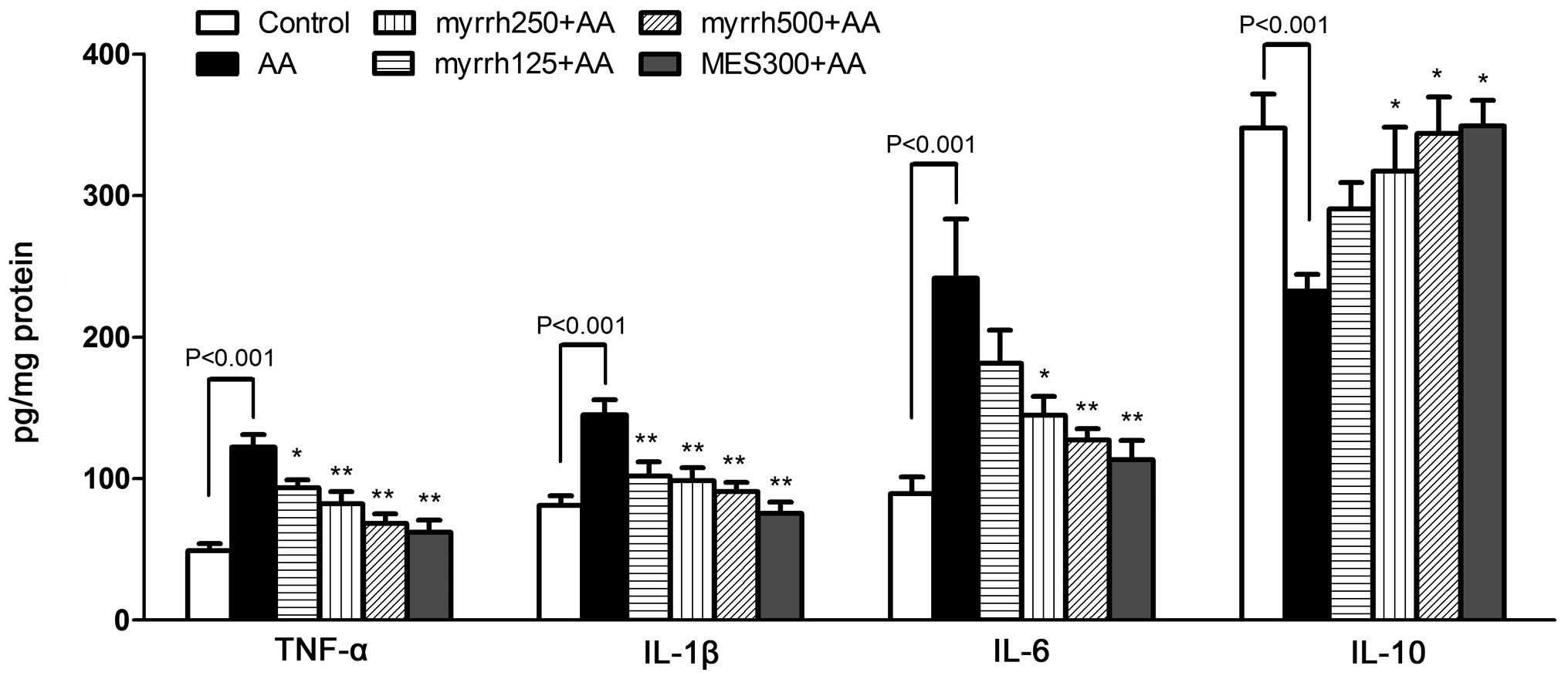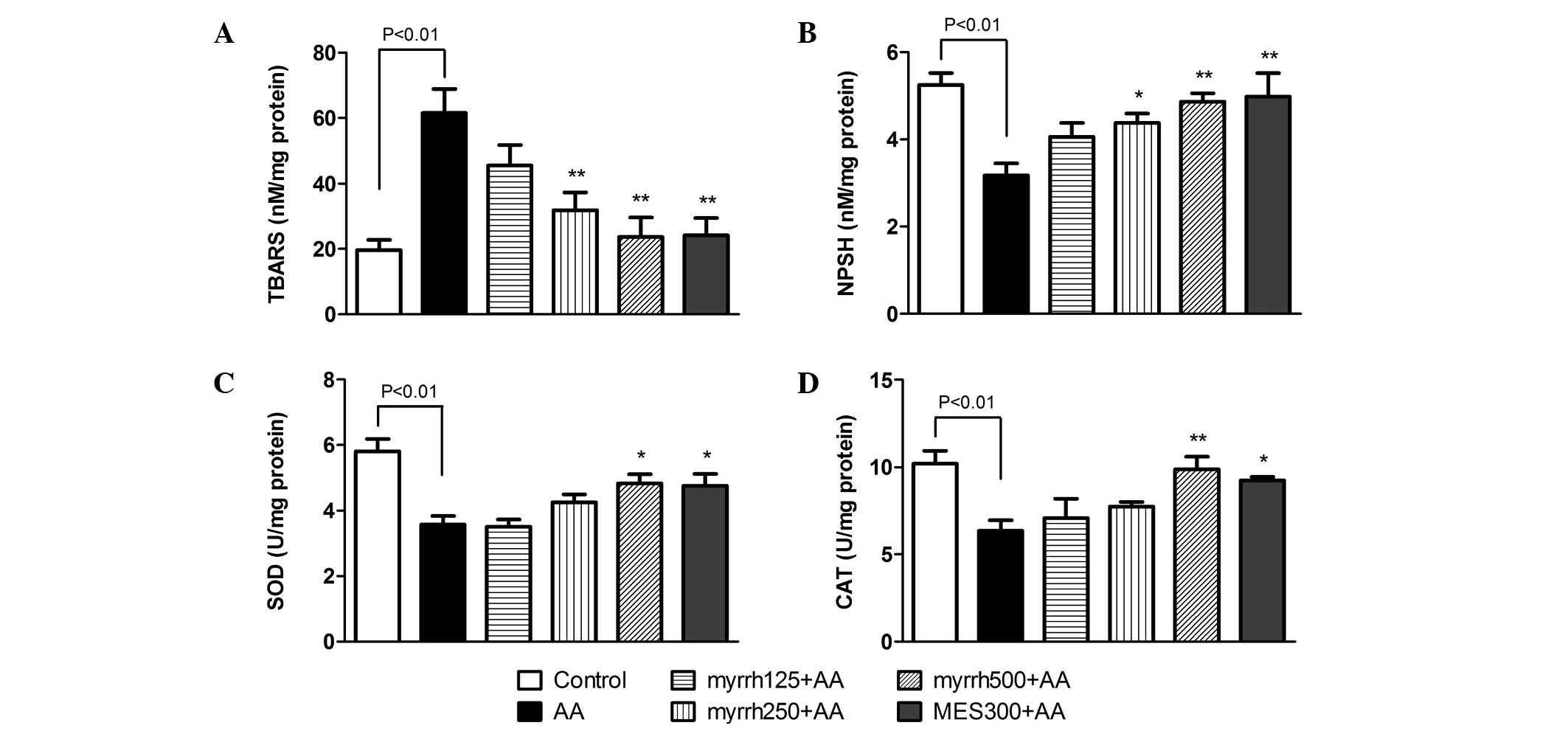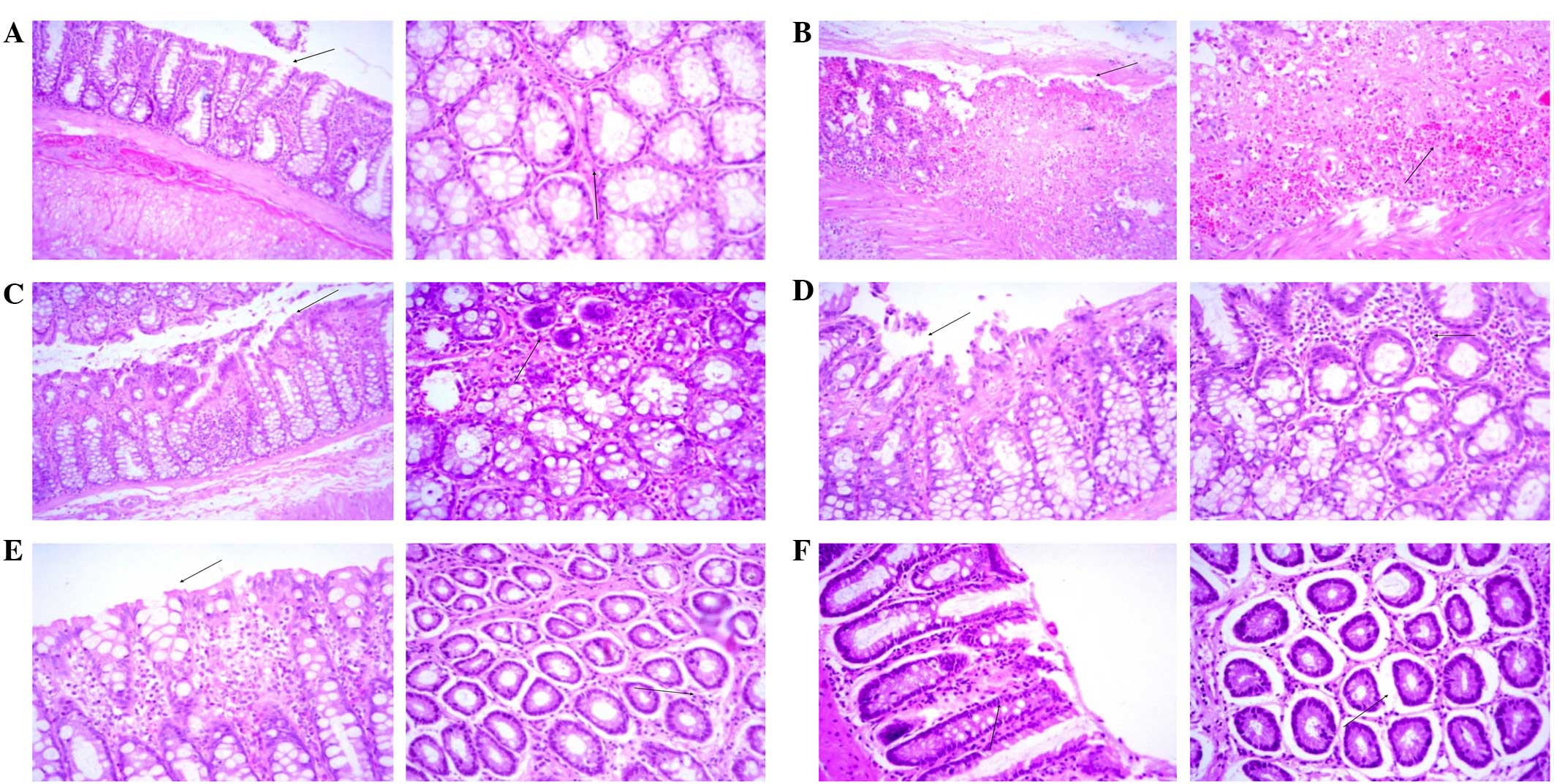|
1
|
Safarpour AR, Hosseini SV and Mehrabani D:
Epidemiology of inflammatory bowel diseases in iran and Asia; a
mini review. Iran J Med Sci. 38(Suppl 2): S140–S149. 2013.
|
|
2
|
Xavier RJ and Podolsky DK: Unravelling the
pathogenesis of inflammatory bowel disease. Nature. 448:427–434.
2007. View Article : Google Scholar : PubMed/NCBI
|
|
3
|
Mehrabani D, Tabei ST, Heydari SJ,
Shamsina SJ, Shokrpour N, Amini M, Masoumi SJ, Julaee H, Farahmand
M and Manafi A: Cancer occurrence in Fars Province, Southern Iran.
Iran Red Crescent Med J. 10:314–322. 2008.
|
|
4
|
Cetinkaya A, Bulbuloglu E, Kantarceken B,
Ciralik H, Kurutas EB, Buyukbese MA and Gumusalan Y: Effects of
L-carnitine on oxidant/antioxidant status in acetic acid-induced
colitis. Dig Dis Sci. 51:488–494. 2006. View Article : Google Scholar : PubMed/NCBI
|
|
5
|
Cetinkaya A, Bulbuloglu E, Kurutas EB,
Ciralik H, Kantarceken B and Buyukbese MA: Beneficial effects of
N-acetylcysteine on acetic acid-induced colitis in rats. Tohoku J
Exp Med. 206:131–139. 2005. View Article : Google Scholar : PubMed/NCBI
|
|
6
|
Seo HG, Takata I, Nakamura M, Tatsumi H,
Suzuki K, Fujii J and Taniguchi N: Induction of nitric oxide
synthase and concomitant suppression of superoxide dismutases in
experimental colitis in rats. Arch Biochem Biophys. 324:41–47.
1995. View Article : Google Scholar : PubMed/NCBI
|
|
7
|
Larrick JW and Wright SC: Cytotoxic
mechanism of tumor necrosis factor-alpha. FASEB J. 4:3215–3223.
1990.PubMed/NCBI
|
|
8
|
Bertevello PL, Logullo AF, Nonogaki S,
Campos FM, Chiferi V, Alves CC, Torrinhas RS, Gama-Rodrigues JJ and
Waitzberg DL: Immunohistochemical assessment of mucosal cytokine
profile in acetic acid experimental colitis. Clinics (Sao Paulo).
60:277–286. 2005. View Article : Google Scholar : PubMed/NCBI
|
|
9
|
Pacher P, Beckman JS and Liaudet L: Nitric
oxide and peroxynitrite in health and disease. Physiol Rev.
87:315–424. 2007. View Article : Google Scholar : PubMed/NCBI
|
|
10
|
Rachmilewitz D, Karmeli F, Okon E,
Rubenstein I and Better OS: Hyperbaric oxygen: A novel modality to
ameliorate experimental colitis. Gut. 43:512–518. 1998. View Article : Google Scholar : PubMed/NCBI
|
|
11
|
Chassaing B, Aitken JD, Malleshappa M and
Vijay-Kumar M: Dextran sulfate sodium (DSS)-induced colitis in
mice. Curr Protoc Immunol. 104:Unit 15.25. 2014. View Article : Google Scholar : PubMed/NCBI
|
|
12
|
Mehrabani D, Ziaei M, Hosseini SV,
Ghahramani L, Bananzadeh AM, Ashraf MJ, Amini A, Amini M and
Tanideh N: The effect of calendula officinalis in therapy of acetic
Acid induced ulcerative colitis in dog as an animal model. Iran Red
Crescent Med J. 13:884–890. 2011.PubMed/NCBI
|
|
13
|
Redwan el-RM and Tabll A: Camel
lactoferrin markedly inhibits hepatitis C virus genotype 4
infection of human peripheral blood leukocytes. J Immunoassay
Immunochem. 28:267–277. 2007. View Article : Google Scholar : PubMed/NCBI
|
|
14
|
Hanuš LO, Řezankab T, Dembitskya VM and
Moussaieff A: Myrrh-Commiphora chemistry. Biomed Papers.
149:3–28. 2005. View Article : Google Scholar
|
|
15
|
Mugah JO, Chikamai BN, Mbiru SS and
Casadei E: Conservation, management and utilization of plant gums,
resins and essential oils. Proceedings of a Regional Conference for
Africa (Nairobi, Kenya). 6–10–Oct;1997.
|
|
16
|
Massoud A, El Sisi S, Salama O and Massoud
A: Preliminary study of therapeutic efficacy of a new fasciolicidal
drug derived from Commiphora molmol (myrrh). Am J
Trop Med Hyg. 65:96–99. 2001.PubMed/NCBI
|
|
17
|
Shalaby MA and Ashraf Hammouda AA:
Analgesic, anti-inflammatory and anti-hyperlipidemic activities of
Commiphora molmol extract (Myrrh). J Intercult
Ethnopharmacol. 3:56–62. 2014.PubMed/NCBI
|
|
18
|
El-Sherbiny GM and El Sherbiny ET: The
effect of Commiphora molmol (Myrrh) in treatment of
Trichomoniasis vaginalis infection. Iran Red Crescent Med J.
13:480–486. 2011.PubMed/NCBI
|
|
19
|
El Ashry ES, Rashed N, Salama OM and Saleh
A: Components, therapeutic value and uses of myrrh.
Pharmazie. 58:163–168. 2003.PubMed/NCBI
|
|
20
|
al-Harbi MM, Qureshi S, Raza M, Ahmed MM,
Afzal M and Shah AH: Gastric antiulcer and cytoprotective effect of
Commiphora molmol in rats. J Ethnopharmacol. 55:141–150.
1997. View Article : Google Scholar : PubMed/NCBI
|
|
21
|
al-Harbi MM, Qureshi S, Ahmed MM,
Rafatullah S and Shah AH: Effect of Commiphora molmol
(oleo-gum-resin) on the cytological and biochemical changes induced
by cyclophosphamide in mice. Am J Chin Med. 22:77–82. 1994.
View Article : Google Scholar : PubMed/NCBI
|
|
22
|
Qureshi S, al-Harbi MM, Ahmed MM, Raza M,
Giangreco AB and Shah AH: Evaluation of the genotoxic, cytotoxic
and antitumor properties of Commiphora molmol using normal
and Ehrlich ascites carcinoma cell-bearing Swiss albino mice.
Cancer Chemother Pharmacol. 33:130–138. 1993. View Article : Google Scholar : PubMed/NCBI
|
|
23
|
Su S, Hua Y, Wang Y, Gu W, Zhou W, Duan
JA, Jiang H, Chen T and Tang Y: Evaluation of the anti-inflammatory
and analgesic properties of individual and combined extracts from
Commiphora myrrha and Boswellia carterii. J
Ethnopharmacol. 139:649–656. 2012. View Article : Google Scholar : PubMed/NCBI
|
|
24
|
Sofowora A: Medicinal plants and
traditional medicine in Africa. John Wiley and Sons Ltd.
Chichester: 1982.
|
|
25
|
AOAC: Official Methods of Analysis (15th).
Association of Official Analytical Chemists, Inc. Arlington,
Virginia: 1990.
|
|
26
|
Mousavizadeh K, Rahimian R, Fakhfouri G,
Aslani FS and Ghafourifar P: Anti-inflammatory effects of 5-HT
receptor antagonist, tropisetron on experimental colitis in rats.
Eur J Clin Invest. 39:375–383. 2009. View Article : Google Scholar : PubMed/NCBI
|
|
27
|
Popov SV, Markov PA, Nikitina IR,
Petrishev S, Smirnov V and Ovodov YS: Preventive effect of a pectic
polysaccharide of the common cranberry Vaccinium oxycoccos L. on
acetic acid-induced colitis in mice. World J Gastroenterol.
12:6646–6651. 2006. View Article : Google Scholar : PubMed/NCBI
|
|
28
|
Sedlak J and Lindsay RH: Estimation of
total, protein-bound, and nonprotein sulfhydryl groups in tissue
with Ellman's reagent. Anal Biochem. 25:192–205. 1968. View Article : Google Scholar : PubMed/NCBI
|
|
29
|
Kono Y: Generation of superoxide radical
during autoxidation of hydroxylamine and an assay for superoxide
dismutase. Arch Biochem Biophys. 186:189–195. 1978. View Article : Google Scholar : PubMed/NCBI
|
|
30
|
Monk LS, Fagerstedt KV and Crawford RM:
Superoxide dismutase as an anaerobic polypeptide: A key Factor in
recovery from oxygen deprivation in Iris pseudacorus? Plant
Physiol. 85:1016–1020. 1987. View Article : Google Scholar : PubMed/NCBI
|
|
31
|
Aebi H: Catalase. Methods of Enzymatic
Analysis. Bergmeyer HU: Academic Press. (New York). 674–684.
1974.
|
|
32
|
Bregman AA: Laboratory Investigations in
Cell Biology. John Wiley and Sons. New York: 1983.
|
|
33
|
Lowry OH, Rosebrough NJ, Farr AL and
Randall RJ: Protein measurement with the Folin phenol reagent. J
Biol Chem. 193:265–275. 1951.PubMed/NCBI
|
|
34
|
Mehrabani D, Bahrami F, Hosseini SV,
Ashraf MJ, Tanideh N, Rezaianzadeh A, Amini M and Amini A: The
healing effect of teucrium polium in acetic acid-induced ulcerative
colitis in the dog as an animal model. Middle East J Dig Dis.
4:40–47. 2012.PubMed/NCBI
|
|
35
|
Bhattacharyya A, Chattopadhyay R, Mitra S
and Crowe SE: Oxidative stress: An essential factor in the
pathogenesis of gastrointestinal mucosal diseases. Physiol Rev.
94:329–354. 2014. View Article : Google Scholar : PubMed/NCBI
|
|
36
|
Hemnani T and Parihar MS: Reactive oxygen
species and oxidative DNA damage. Indian J Physiol Pharmacol.
42:440–452. 1998.PubMed/NCBI
|
|
37
|
Rezaie A, Parker RD and Abdollahi M:
Oxidative stress and pathogenesis of inflammatory bowel disease: An
epiphenomenon or the cause? Dig Dis Sci. 52:2015–2021. 2007.
View Article : Google Scholar : PubMed/NCBI
|
|
38
|
Pavlick KP, Laroux FS, Fuseler J, Wolf RE,
Gray L, Hoffman J and Grisham MB: Role of reactive metabolites of
oxygen and nitrogen in inflammatory bowel disease. Free Radic Biol
Med. 33:311–322. 2002. View Article : Google Scholar : PubMed/NCBI
|
|
39
|
Grisham MB: Oxidants and free radicals in
inflammatory bowel disease. Lancet. 344:859–861. 1994. View Article : Google Scholar : PubMed/NCBI
|
|
40
|
El-Abhar HS, Hammad LN and Gawad HS:
Modulating effect of ginger extract on rats with ulcerative
colitis. J Ethnopharmacol. 118:367–372. 2008. View Article : Google Scholar : PubMed/NCBI
|
|
41
|
Harputluoglu MM, Demirel U, Yücel N,
Karadağ N, Temel I, Firat S, Ara C, Aladağ M, Karincaoğlu M and
Hilmioğlu F: The effects of Gingko biloba extract on acetic
acid-induced colitis in rats. Turk J Gastroenterol. 17:177–182.
2006.PubMed/NCBI
|
|
42
|
Duerr RH: Update on the genetics of
inflammatory bowel disease. J Clin Gastroenterol. 37:358–367. 2003.
View Article : Google Scholar : PubMed/NCBI
|
|
43
|
Aleisa AM, Al-Rejaie SS, Abuohashish HM,
Ola MS, Parmar MY and Ahmed MM: Pretreatment of Gymnema
sylvestre revealed the protection against acetic acid-induced
ulcerative colitis in rats. BMC Complement Altern Med. 14:492014.
View Article : Google Scholar : PubMed/NCBI
|
|
44
|
Al-Rejaie SS, Abuohashish HM, Al-Enazi MM,
Al-Assaf AH, Parmar MY and Ahmed MM: Protective effect of
naringenin on acetic acid-induced ulcerative colitis in rats. World
J Gastroenterol. 19:5633–5644. 2013. View Article : Google Scholar : PubMed/NCBI
|
|
45
|
Patel MA, Patel PK and Patel MB: Effects
of ethanol extract of Ficus bengalensis (bark) on inflammatory
bowel disease. Indian J Pharmacol. 42:214–218. 2010. View Article : Google Scholar : PubMed/NCBI
|
|
46
|
Narushima S, Spitz DR, Oberley LW,
Toyokuni S, Miyata T, Gunnett CA, Buettner GR, Zhang J, Ismail H,
Lynch RG and Berg DJ: Evidence for oxidative stress in
NSAID-induced colitis in IL10−/− mice. Free Radic Biol
Med. 34:1153–1166. 2003. View Article : Google Scholar : PubMed/NCBI
|
|
47
|
Hartmann RM, Morgan Martins MI, Tieppo J,
Fillmann HS and Marroni NP: Effect of Boswellia serrata on
antioxidant status in an experimental model of colitis rats induced
by acetic acid. Dig Dis Sci. 57:2038–2044. 2012. View Article : Google Scholar : PubMed/NCBI
|
|
48
|
Buffinton GD and Doe WF: Depleted mucosal
antioxidant defences in inflammatory bowel disease. Free Radic Biol
Med. 19:911–918. 1995. View Article : Google Scholar : PubMed/NCBI
|
|
49
|
Tüzün A, Erdil A, Inal V, Aydin A, Bağci
S, Yeşilova Z, Sayal A, Karaeren N and Dağalp K: Oxidative stress
and antioxidant capacity in patients with inflammatory bowel
disease. Clin Biochem. 35:569–572. 2002. View Article : Google Scholar : PubMed/NCBI
|
|
50
|
Pravda J: Radical induction theory of
ulcerative colitis. World J Gastroenterol. 11:2371–2384. 2005.
View Article : Google Scholar : PubMed/NCBI
|
|
51
|
Ayala A, Muñoz MF and Argüelles S: Lipid
peroxidation: Production, metabolism, and signaling mechanisms of
malondialdehyde and 4-hydroxy-2-nonenal. Oxid Med Cell Longev.
2014:3604382014. View Article : Google Scholar : PubMed/NCBI
|
|
52
|
Boots AW, Haenen GR and Bast A: Health
effects of quercetin: From antioxidant to nutraceutical. Eur J
Pharmacol. 585:325–337. 2008. View Article : Google Scholar : PubMed/NCBI
|
|
53
|
Button LA, Roberts SE, Goldacre MJ, Akbari
A, Rodgers SE and Williams JG: Hospitalized prevalence and 5-year
mortality for IBD: Record linkage study. World J Gastroenterol.
16:431–438. 2010. View Article : Google Scholar : PubMed/NCBI
|
|
54
|
Grisham MB and Yamada T: Neutrophils,
nitrogen oxides, and inflammatory bowel disease. Ann NY Acad Sci.
664:103–115. 1992. View Article : Google Scholar : PubMed/NCBI
|
|
55
|
Sartor RB: Cytokines in intestinal
inflammation: Pathophysiological and clinical considerations.
Gastroenterology. 106:533–539. 1994.PubMed/NCBI
|
|
56
|
Elson CO, Sartor RB, Tennyson GS and
Riddell RH: Experimental models of inflammatory bowel disease.
Gastroenterology. 109:1344–1367. 1995. View Article : Google Scholar : PubMed/NCBI
|
|
57
|
Zhang JM and An J: Cytokines, inflammation
and pain. Int Anesthesiol Clin. 45:27–37. 2007. View Article : Google Scholar : PubMed/NCBI
|
|
58
|
Sanchez-Munoz F, Dominguez-Lopez A and
Yamamoto-Furusho JK: Role of cytokines in inflammatory bowel
disease. World J Gastroenterol. 14:4280–4288. 2008. View Article : Google Scholar : PubMed/NCBI
|
|
59
|
Suzuki A, Hanada T, Mitsuyama K, Yoshida
T, Kamizono S, Hoshino T, Kubo M, Yamashita A, Okabe M, Takeda K,
et al: CIS3/SOCS3/SSI3 plays a negative regulatory role in STAT3
activation and intestinal inflammation. J Exp Med. 193:471–481.
2001. View Article : Google Scholar : PubMed/NCBI
|
|
60
|
Stucchi A, Reed K, O'Brien M, Cerda S,
Andrews C, Gower A, Bushell K, Amar S, Leeman S and Becker J: A new
transcription factor that regulates TNF-alpha gene expression,
LITAF, is increased in intestinal tissues from patients with CD and
UC. Inflamm Bowel Dis. 12:581–587. 2006. View Article : Google Scholar : PubMed/NCBI
|
|
61
|
Tahan G, Aytac E, Aytekin H, Gunduz F,
Dogusoy G, Aydin S, Tahan V and Uzun H: Vitamin E has a dual effect
of anti-inflammatory and antioxidant activities in acetic
acid-induced ulcerative colitis in rats. Can J Surg. 54:333–338.
2011. View Article : Google Scholar : PubMed/NCBI
|
|
62
|
Ashry KM, El-Sayed YS, Khamiss RM and
El-Ashmawy IM: Oxidative stress and immunotoxic effects of lead and
their amelioration with myrrh (Commiphora molmol)
emulsion. Food Chem Toxicol. 48:236–241. 2010. View Article : Google Scholar : PubMed/NCBI
|
|
63
|
Al-Rejaie SS: Effect of oleo-gum-resin on
ethanol-induced hepatotoxicity in rats. J Med Sci. 12:1–9. 2012.
View Article : Google Scholar
|
|
64
|
Rahman MM, Garvey M, Piddock LJ and
Gibbons S: Antibacterial terpenes from the oleo-resin of
Commiphora molmol (Engl.). Phytother Res. 22:1356–1360.
2008. View Article : Google Scholar : PubMed/NCBI
|
|
65
|
Brieskorn CH and Noble P: Three new
furanogermacrenes from myrrh. Tetrahedron Lett.
21:1511–1514. 1980. View Article : Google Scholar
|
|
66
|
Dolara P, Luceri C, Ghelardini C,
Monserrat C, Aiolli S, Luceri F, Lodovici M, Menichetti S and
Romanelli MN: Analgesic effects of myrrh. Nature.
379:291996. View Article : Google Scholar : PubMed/NCBI
|
|
67
|
Tariq M, Ageel AM, Al-Yahya MA, Mossa JS,
Al-Said MS and Parmar NS: Anti-inflammatory activity of
Commiphora molmol. Agents Actions. 17:381–382. 1986.
View Article : Google Scholar : PubMed/NCBI
|
|
68
|
Tipton DA, Lyle B, Babich H and Dabbous
MKh: In vitro cytotoxic and anti-inflammatory effects of
myrrh oil on human gingival fibroblasts and epithelial
cells. Toxicol In vitro. 17:301–310. 2003. View Article : Google Scholar : PubMed/NCBI
|



















